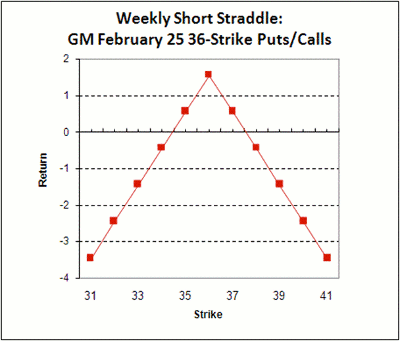Here’s how one trader used weeklies to execute a short straddle on General Motors heading into the automaker’s major earnings announcement this morning.
Ahead of the open today (Thursday, Feb. 24), Detroit darling General Motors Co. (GM) is scheduled to release its fourth-quarter and fiscal 2010 earnings results. For the fourth quarter, Wall Street is expecting a profit of 47 cents per share, with full-year earnings seen arriving at $2.87 per share. Concerns have mounted heading into GM's quarterly report, especially after fellow automaker Ford Motor Co. (F) missed the consensus fourth-quarter estimate on Jan. 28.
In the options pits, call buying has been quite popular among traders on the International Securities Exchange (ISE), Chicago Board Options Exchange (CBOE), and Nasdaq OMX PHLX (PHLX) lately, as GM's collective ten-day call/put volume ratio arrives at 2.86. In other words, the number of calls bought to open has nearly tripled the number of puts purchased during the prior two weeks.
While call buying typically denotes bullish options activity, recent short-selling activity could dampen this sentiment takeaway. Specifically, the number of GM shares sold short spiked by 32% during the past month. As such, some of this recent call-buying activity on GM may be the work of short sellers hedging their positions, and not options traders betting on a rally in the stock.
Turning back to today's options activity, volume is once again skewed toward the call side, with roughly 10,600 calls changing hands, as compared to more than 7,000 puts. Digging deeper into GM's options activity, I came across several blocks of puts and calls that changed hands at the bid prices. Additional research uncovered what appears to be a short straddle on GM using weekly options.
The Anatomy of a Weekly General Motors Short Straddle
Short straddles have apparently gained in popularity recently, with retail concern Nordstrom Inc. (JWN) becoming the object a similar trade last week. While today's short straddle in GM involves weekly options, its construction is the same as the JWN straddle.
Specifically, the trader sold 127 GM February 25 36-strike calls at 9:44 am ET on the ISE for the bid price of $0.68, or $68 per contract. At the same time, the trader also sold 127 February 25 36-strike puts for the bid price of $0.87, or $87 per contract. The result is a net credit of $1.55, or $155 per pair of contracts.
The position reaches its maximum profit if GM closes at $36 per share when these weekly options expire this Friday. In this best-case scenario, both the sold February 25 36-strike calls and puts would expire worthless, allowing the trader to retain the entire premium collected.
There are two breakeven points for this position, and they are calculated by adding and subtracting the net credit received to/from the sold strike. For example, the breakevens are $37.55 (36 + $1.55) and $34.45 (36 - $1.55).
Finally, the maximum loss on a downside move is limited to the strike price minus the net credit received, which comes in at $34.45, or $3,445 per pair of contracts. This is reached if GM were to drop to zero at expiration. Meanwhile, the maximum loss on an upside move is theoretically unlimited, as there is no limit to how high GM can rally. Below is a chart for a rough visual representation:
By Joseph Hargett, contributor, Schaeffer’s Trading Floor Blog













